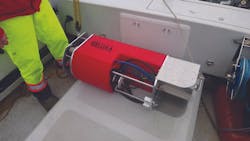Underwater Array Shines for Surveillance
Missions requiring underwater surveillance received a strong assist from the Vigilus underwater robotics system (see image above) from Cellula Robotics Ltd. The submersible surveillance array, based on acoustically meshed environmental sensor nodes, operates with multiple nodes set kilometers apart on a seafloor to form an interconnected network of listening stations (see figure below).
Because the network operates without cable connects, it can be deployed covertly by small watercraft or by an uncrewed underwater vehicle (UUV). The nodes function effectively in hostile environments, such as beneath ice sheets, supporting efficient surveillance in the waters of the Arctic region.
The Vigilus nodes are capable of collecting, processing, encrypting, and responding to acoustic events and environmental changes as needed, rapidly generating alerts. The nodes can share alert information and transmit information to other systems in the vicinity, such as UUVs, as well as to a Vigilus shoreside gateway for secure, near-real-time warnings of undersea activity. Each node can also emit acoustic “pings” to serve as a deterrent or warning to watercraft and systems in the vicinity.
Regarding the product introduction, the CEO of Cellula Robotics, Neil Manning, said, “We are excited to bring this innovation to the market. Vigilus will empower our customers to operate with enhanced confidence and security in the most challenging underwater environments, including the Arctic region.”
About the Author
Jack Browne
Technical Contributor
Jack Browne, Technical Contributor, has worked in technical publishing for over 30 years. He managed the content and production of three technical journals while at the American Institute of Physics, including Medical Physics and the Journal of Vacuum Science & Technology. He has been a Publisher and Editor for Penton Media, started the firm’s Wireless Symposium & Exhibition trade show in 1993, and currently serves as Technical Contributor for that company's Microwaves & RF magazine. Browne, who holds a BS in Mathematics from City College of New York and BA degrees in English and Philosophy from Fordham University, is a member of the IEEE.


